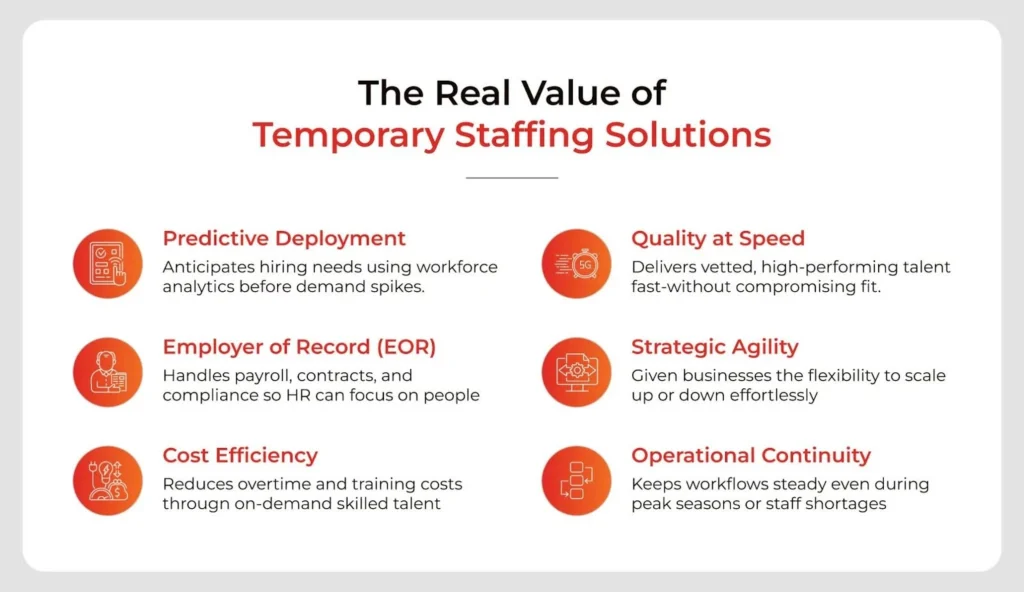Every holiday season tells the same story with brimming storefronts, late-night logistics, and customer queues that seem endless. Yet behind the festive cheer lies a quiet scramble within organizations. Orders surge, operations stretch, and managers face the impossible equation of doing more with the same number of hands.
The problem isn’t a lack of preparation; it’s the unpredictability of demand. One week, the forecast holds steady; the next, it’s shattered by an unexpected spike. Retail, logistics, healthcare, and even tech support face their own version of the seasonal storm. And when every minute counts, the real differentiator isn’t who works the hardest, but who adapts the fastest.
That’s where temporary staffing for holidays proves invaluable. It gives organizations the breathing room to scale without chaos, ensuring that business continuity isn’t sacrificed at the altar of festive demand. Done strategically, it’s about sustaining excellence when pressure peaks. In other words, it’s how smart companies turn the most volatile quarter of the year into their strongest one.
Also Read: Direct Hire vs. Temp-to-Hire: Which Offers Better ROI?
Why the Holiday Season Tests Workforce Resilience
Holidays are predictable. What’s not predictable is how intense each season will be. Even seasoned HR leaders with years of data find themselves facing new variables. Think sudden surges in online orders, supplier bottlenecks, or customer trends that shift overnight.
Imagine a retailer whose holiday traffic overshot forecasts not by five percent, but by nearly thirty. Their web platform held strong; the failure point was their fulfillment center. They had inventory, but not enough hands to move it.
When that happens, even well-stocked shelves can’t guarantee timely delivery. The absence of sufficient labor becomes the invisible bottleneck, delaying shipments and disappointing customers.
The lesson is clear: missed delivery windows or unshipped orders rarely stem from supply constraints alone. More often, they arise from workforce gaps.
That’s the core challenge seasonal hiring resolves, maintaining productivity during the holidays without overburdening full-time teams or compromising service quality.
This is where temporary staffing solutions serve as shock absorbers, absorbing sudden spikes, sustaining workflows, and protecting the integrity of the customer experience.
The Real Value of Temporary Staffing Solutions

Contrary to the old belief, temporary staffing isn’t just about “filling roles fast.” It is more about strategic agility. The best organizations today see staffing partners as extensions of their workforce planning units. They help with:
1. Predictive Deployment Instead of Reactive Hiring
Top temporary staffing agencies today rely on predictive workforce analytics. By studying client demand cycles, regional hiring data, and even local logistics patterns, they can anticipate when and where demand will rise, sometimes before the client does.
Think of it like an air traffic control tower. When multiple flights (read: business units) are approaching the runway simultaneously, only a skilled controller (your staffing partner) can ensure each one lands smoothly, without delays or collisions.
2. Quality at Speed
The myth that speed compromises quality has long been broken. Leading staffing solutions firms use AI-driven matching tools and human intelligence together, vetting candidates for not just skills but cultural fit, reliability, and performance in high-pressure environments.
For example, a logistics company preparing for Christmas deliveries may receive dozens of temporary drivers within 72 hours, all pre-verified for compliance and route familiarity. The difference lies in how well the staffing partner has built and maintained its candidate ecosystem over time.
3. Employer of Record (EOR) Advantage
For many companies, onboarding seasonal staff is a compliance headache. Who manages payroll? Who ensures benefits?
The answer lies in the employer of record model, where the staffing firm becomes the legal employer for temporary talent. This frees up your HR from complex paperwork, enabling them to focus on what matters: productivity and engagement.
Also Read: 5 Key Benefits of Project Staffing for Fast-Growing Teams
Planning Ahead: Timing Is Everything
How early should companies start planning holiday recruitment? The short answer: earlier than they think.
The long answer: businesses that begin workforce planning at least 8–10 weeks before the seasonal surge experience fewer fulfillment delays, lower absenteeism, and higher retention post-season.
Here’s a quick framework used by several SPECTRAFORCE clients:
- Phase 1: Forecasting (Q3) – Assess business demand, peak timelines, and previous gaps.
- Phase 2: Partner Engagement (Q3 end) – Lock in your temporary staffing agencies and define role expectations.
- Phase 3: Candidate Pipeline (Q4 start) – Pre-screen and prepare pools of trained temp staff.
- Phase 4: Onboarding (just before peak) – Deploy short-term staffing solutions with compliance and EOR readiness.
Planning is insurance against chaos. And the earlier you start, the smoother your season runs.
From Chaos to Coordination: How Businesses Can Respond
Across industries, workforce surges rarely come with warning. One moment operations feel balanced, and the next, demand outpaces manpower by miles. Retail, healthcare, logistics, manufacturing, each faces its own version of the seasonal scramble. And in those moments, agility separates the prepared from the panicked.
In retail and e-commerce, for instance, a sudden upswing in orders may overwhelm fulfillment centers overnight. Systems can hold steady, but without the extra hands to process shipments, even the most efficient operations begin to slow. Temporary associates brought in through seasonal staffing services can help absorb that load, maintaining speed, reducing overtime stress, and preventing costly delays in customer delivery.
In healthcare and diagnostics, the surge may look different but feels just as urgent. During high-volume months, patient inflows often exceed the capacity of permanent teams. By turning to professional temporary staffing solutions, hospitals can onboard qualified nurses, technicians, or administrative personnel on short notice, safeguarding patient care without burning out their core workforce.
These scenarios illustrate a broader pattern seen year after year: when workload peaks collide with limited labor capacity, temporary staffing solutions act as stabilizers. They give organizations the elasticity to scale up and down smoothly, protecting performance, morale, and customer experience.
When viewed through this lens, temporary staffing converts unpredictability into preparedness, ensuring that what might have been chaos instead becomes coordination.
Bridging the Gap Between Tech and Talent
The future of temporary staffing solutions lies at the intersection of data and human insight.
Yes, predictive analytics, AI-driven matching, and skill databases are powerful. But human judgment, intuition about attitude, adaptability, and cultural alignment, still drives the final match.
At SPECTRAFORCE, recruiters often describe their role as “translators”, decoding both business language and human potential. That’s the difference between hiring a person for a shift and building a workforce that fuels your holiday success story.
Final Words
Temporary staffing is now a strategy for resilience, cost optimization, and brand continuity.
But to truly beat the holiday rush, leaders must reframe how they view these partnerships.
Instead of asking, “How fast can we fill these roles?” ask, “How can our staffing partner help us forecast, adapt, and outperform competition during volatility?”
Here’s how forward-thinking companies are already doing that:
- Integrating staffing forecasts into overall demand planning.
- Using seasonal hiring strategies to identify recurring skill sets and train return hires.
- Deploying holiday staffing solutions that double as talent scouting exercises for future full-time roles.
Ready to strengthen your workforce strategy before the next surge?
Partner with SPECTRAFORCE to build flexible, data-driven staffing models that adapt to your business rhythm, season after season.
FAQs
How early companies should start planning holiday recruitment depends on their industry cycle, but ideally, planning should begin at least 8–10 weeks before the holiday surge. This ensures enough time for workforce forecasting, partner onboarding, and pre-training of seasonal staff. Starting early allows companies to secure top talent before competition peaks and to deploy holiday staffing solutions seamlessly.
The employer of record for seasonal staff depends on the staffing arrangement. In most cases, the staffing agency acts as the employer of record (EOR), managing payroll, contracts, taxes, and compliance. This means the agency assumes the legal responsibilities of employment, while the client company benefits from workforce flexibility without the administrative overhead, a key advantage of temporary staffing agencies.
Yes, you can hire a seasonal worker as a permanent employee. Many organizations treat seasonal roles as a trial window to evaluate long-term fit. If a worker performs well and aligns with company culture, transitioning them to a full-time role is not only possible but often encouraged. Some companies even design seasonal hiring strategies specifically to identify future permanent employees from their temp pools.
The roles most impacted by seasonal workload spikes vary by industry, but generally include retail associates, warehouse staff, logistics drivers, customer service agents, and healthcare support professionals. These are the roles where volume and urgency peak simultaneously, and where short-term staffing solutions provide immediate relief. By planning ahead, organizations can ensure these functions never become bottlenecks.
The definition of temporary staffing and how temporary staffing agencies work is simple yet strategic. Temporary staffing involves hiring employees for a fixed period to meet short-term operational needs. Agencies source, screen, and manage these workers, acting as intermediaries between employers and candidates. They handle compliance, contracts, and payroll, allowing businesses to stay focused on performance instead of administration.



